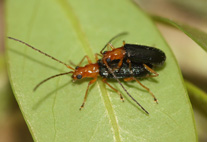Abstract
Two new species of cheilostome Bryozoa are described from continental-slope habitats off Mauritania, including canyon and cold-water coral (mound) habitats. Internal structures of both species were visualised and quantified using microcomputed tomographic (micro-CT) methods. Cellaria bafouri n. sp. is characterised by the arrangement of zooids in alternating longitudinal rows, a smooth cryptocyst, and the presence of an ooecial plate with denticles. Smittina imragueni n. sp. exhibits many similarities with Smittina cervicornis (Pallas, 1766), but differs especially in the shape and orientation of the suboral avicularium. Observations on Smittina imragueni and material labelled as Smittina cervicornis suggest that the latter represents a species group, members of which have not yet been discriminated, possibly because of high intracolony variation and marked astogenetic changes in surface morphology. Both new species are known only from the habitats where they were collected, probably reflecting the paucity of bryozoan sampling from this geographic area and depth range. Both species are able to tolerate low oxygen concentration, which is assumed to be compensated by the high nutrient supply off Mauritania. The application of micro-CT for the semiautomatic quantification of zooidal skeletal characters was successfully tested. We were able to automatically distinguish individual zooidal cavities and acquire corresponding morphological datasets. Comparing the obtained results with conventional SEM measurements allowed ascertaining the reliability of this new method. The employment of micro-CT allows the observation and quantification of previously unseen characters that can be used in describing and differentiating species that were previously indistinguishable. Furthermore, this method might help elucidate processes of colony growth and the function of individual zooids during this process.

